- Home
- Oliver Sacks
Seeing Voices Page 9
Seeing Voices Read online
Page 9
How then should we characterize their deficiency? We need another kind of characterization, one that transcends the usual linguistic categories of syntax, semantics, phonetics. Such a characterization has again been provided by Goldberg in his reflections on “isolated right hemisphere speech.” Right hemisphere language allows ad hoc referential relations (pointing to, labeling, this-here-now)—the establishing of a referential basis of a linguistic code—but cannot go beyond this to allow manipulations of the code, or internal derivations within it. In more general terms, right hemisphere functioning is restricted to perceptual organization and cannot shift to categorical, definition-based lexical organization; it is (in Zaidel’s term) “experiential” only and cannot embrace the “paradigmatic.”63
This referential processing, with complete absence of rule manipulation, is precisely what we see in deaf people who are linguistically defective. Their language, their lexical organization, is like that of people with right hemisphere speech. Such a condition is usually associated with left hemisphere damage, acquired in later life, but it could also arise as a mishap in development—as a failure to shift from an initial, right hemisphere, quasi-perceptual functioning to a mature, left hemisphere, fully linguistic functioning.
Is there any evidence that this does indeed occur in linguistically defective, low-functioning deaf people? Lenneberg questioned whether a large number of the congenitally deaf might have poorly established cerebral lateralization, though at the time (1967) there had not yet been any precise delineation of the differential lexical capacities and characters of the hemispheres in isolation. The matter has been approached, neurophysiologically, by Neville, who writes, “If language experience does impact cerebral development, then aspects of cerebral specialization ought to be different in deaf and hearing subjects when they read English.” And indeed she finds that the majority of deaf people she tested do not show the pattern of left hemisphere specialization observed in the hearing. This, she hypothesizes, is because they lack full grammatical competence in English. And indeed, four congenitally deaf subjects of Neville’s who had perfect English grammar showed “normal” left hemisphere specialization. Thus, in Neville’s words, “grammatical competence is necessary and sufficient for left hemisphere specialization—if it occurs early.”
It is clear from the phenomenological descriptions of Rapin and Schlesinger, and from the behavioral and neurophysiological evidence amassed by Neville, that language experience can grossly alter cerebral development—and that if it is severely deficient, or otherwise aberrant, it may delay the maturation of the brain, preventing proper left hemisphere development, in effect confining the person to a right hemisphere sort of language.64
It is not clear how long-lasting such delays may be; Schlesinger’s observations suggest that, if not prevented, they may be lifelong. But they can be mitigated, and even reversed, by the right sort of intervention later, in adolescence.65 Thus Braefield, a primary school, presents a horrifying picture but a few years later, as adolescents, the same students—or many of them—may be doing better, for example, at Lexington, a secondary school. (And, in quite a different mode from “intervention,” there may be a belated discovery of the deaf world, and this can provide a linguistic intimacy and a culture and community, an at-long-last “coming home” that may compensate somewhat for earlier isolation.)
These, then, in very general terms, are the neurological hazards of congenital deafness. Neither language nor the higher forms of cerebral development occur “spontaneously”; they depend on exposure to language, communication, and proper language use. If deaf children are not exposed, early, to good language or communication, there may be a delay (even an arrest) of cerebral maturation, with a continuing predominance of right hemisphere processes and a lag in hemispheric “shift.” But if language, a linguistic code, can be introduced by puberty, the form of the code (speech or Sign) does not seem to matter; it matters only that it be good enough to allow internal manipulation—then the normal shift to left hemisphere predominance can occur. And if the primary language is Sign, there will be, additionally, an enhancement of many sorts of visual-cognitive ability, all going along with a shift from right hemisphere to left hemisphere dominance.66
Very recently, there have been some fascinating observations with regard to the brain’s disposition to sign language when it is exposed to it—in particular, its tendency toward ASL-like, or (in more general terms) Sign-like, forms whatever form of sign language it is exposed to. Thus James Paul Gee and Wendy Goodhart have shown dramatically that when deaf children are exposed to signed forms of English (manually encoded English), but not ASL, they “tend to innovate ASL-like forms with little or no input in that language.” This is an astonishing finding: that a child who has never seen ASL nonetheless evolves ASL-like forms.
Elissa Newport and Ted Supalla have shown that children construct grammatically perfect ASL even when they are exposed (as they so often are) to somewhat less-than-perfect ASL—a clear illustration of an innate grammatical competence in the brain.67 Gee and Goodhart’s findings go further, by showing that the brain moves inevitably toward Sign-like forms, and will even “convert” non-Sign-like forms to Sign-like-forms. “Sign is closer to the language of the mind,” as Edward Klima says, and thus more “natural” than anything else when the developing child is called upon to construct a language in the manual mode.
Sam Supalla has provided independent confirmation of these studies.68 Focusing in particular on the sort of devices used to mark grammatical relations (these are all spatial in ASL, but in signed English, as in spoken English, entirely sequential), he has found that deaf children exposed only to signed English replace its grammatical devices with purely spatial ones “similar to those found in ASL or other natural signed languages.” Supalla speaks of these as being “spontaneously created,” or evolved.
It has been known for many years that signed English is cumbersome and imposes a strain on those who use it: “Deaf people,” writes Bellugi, “have reported to us that while they can process each item as it appears, they find it difficult to process the message content as a whole when all the information is expressed in the sign stream as sequential elements.” These difficulties, which do not diminish with use, are due to fundamental neurological limitations—in particular, of short-term memory and cognitive processing. None of these difficulties occurs with ASL, which with its spatial devices is perfectly adapted to a visual mode, and can be easily signed and understood at high speed. The overloading of short-term memory and cognitive capacity that occurs with signed English in deaf adults is experienced as difficulty and strain. But in deaf children, who still have the capacity to create grammatical structures—so Supalla hypothesizes—the cognitive difficulties involved in trying to learn signed speech force the children to create their own linguistic structures, to create or evolve a spatial grammar.
If deaf children are exposed only to signed English, Supalla has further shown, they may exhibit “impaired potential for natural language acquisition and processing,” impairment of their capacity to create and comprehend grammar, unless they are able to create their own linguistic structures. Fortunately, being children, and still at a “Chomskian” age, they are able to create their own linguistic structures, their own spatial grammar. They resort to doing this in order to ensure their own linguistic survival.
These findings on the spontaneous origination of Sign, or Sign-like linguistic structures, in children may cast a very important light on the origin and evolution of Sign in general. For it appears as if the nervous system, given the constraints of language in a visual medium, and the physiological limitations of short-term memory and cognitive processing, has to evolve the sort of linguistic structures, the sort of spatial organization, we see in Sign. And there is strong circumstantial support for this in the fact that all indigenous signed languages—and there are many hundreds, all over the world, which have evolved separately and independently wherever there are group
s of deaf people69 —all indigenous signed languages have much the same spatial structure. None of them resembles signed English, or signed speech, in the least. All have, beneath their specific differences, some generic resemblance to ASL. There is no universal sign language, but there are, it seems, universals in all sign languages, universals not of meaning, but of grammatical form.70
There is good reason to suppose (though the evidence is circumstantial rather than direct) that general linguistic competence is genetically determined and is essentially the same in all human beings. But the particular form of grammar—what Chomsky calls “surface” grammar (whether this be the grammar of English or Chinese or Sign)—is determined by the experience of the individual; it is not a genetic endowment but an epigenetic achievement. It is “learned,” or perhaps one should say, for we are dealing with something primitive and preconscious, it evolves through the interaction of a general (or abstract) linguistic competence and the particularities of experience—an experience which, in the deaf, is distinctive, indeed unique, because it is in a visual mode.
What Gee and Goodhart, and Samuel Supalla, observe is an evolution, a startling (and radical) modification of grammatical forms, under the influence of this visual necessity. They describe a change, a grammatical form changing visibly before the eyes, becoming spatialized, as signed English is “turned into” an ASL-like language. They depict an evolution of grammatical forms—but an evolution occurring within the course of a few months.
Language is actively modified, the brain itself is actively modified, as it develops a wholly new capacity to “linguisticize” space (or to spatialize language). As the brain does this, it simultaneously develops all the other visual-cognitive, but non-linguistic, enhancements that Bellugi and Neville have described. There must be physiological and (could we but see them) anatomical shiftings and reorganizations in the micro-structure of the brain. Neville conceives the brain as having, at first, a great neuronal redundancy and plasticity, and of this being subsequently “pruned” by experience, here reinforcing synapses, connections between nerve cells, there inhibiting or suppressing them, according to the competing pressures of different sensory inputs. It is clear that genetic endowment alone cannot explain the full connectional complexity of the nervous system—whatever invariants are predetermined, additional diversity emerges during development. This postnatal development, or epigenesis, is the central concern of Jean-Pierre Changeux’s work.
But a more radical suggestion, indeed a wholly different way of thinking, has recently been put forward by Gerald Edelman.71 The unit of selection for Changeux is the individual neuron; the unit of selection for Edelman is the neuronal group, and it is only at this level, with selection of different neuronal groups or populations under competitive pressures, that evolution (as distinct from mere growth or development) may be said to occur. This allows Edelman to produce a model which is essentially biological, indeed Darwinian, in nature.72 Darwin conceives of natural selection occurring in populations in response to environmental pressures. Edelman sees this as continuing in the organism (he speaks here of “somatic selection”), determining the individual development of the nervous system. The fact that populations of nerve cells, and not merely individual cells, are involved allows far more complex potentials for change.
Edelman’s theory provides a detailed picture of how neuronal “maps” can be formed, which allow an animal to adapt (without innate programs or instruction) to wholly new perceptual challenges, to create or construct new perceptual forms and categorizations, new orientations, new approaches to the world. This is precisely the situation of the deaf child: he is flung into a perceptual (and cognitive and linguistic) situation for which there is neither genetic precedent nor teaching to assist him; and yet, given half a chance, he will develop radically new forms of neural organization, neural mappings, which will allow him to master the language-world, and articulate it, in a quite novel way. It is difficult to think of a more dramatic example of somatic selection, of neural Darwinism, in action.73
To be deaf, to be born deaf, places one in an extraordinary situation; it exposes one to a range of linguistic possibilities, and hence to a range of intellectual and cultural possibilities, which the rest of us, as native speakers in a world of speech, can scarcely even begin to imagine. We are neither deprived nor challenged, linguistically, as the deaf are: we are never in danger of languagelessness, or severe linguistic incompetence; but nor do we discover, or create, a startlingly new language.
The unspeakable experiment of King Psammetichos—who had two children raised by shepherds who never spoke to them, in order to see what (if any) language they would speak naturally—is repeated, potentially, with all children born deaf.74 A small number—perhaps 10 percent of these—are born of deaf parents, exposed to Sign from the start, and become native signers. The rest must live in an aural-oral world, neither biologically, nor linguistically, nor emotionally well-equipped to deal with them. Deafness as such is not the affliction; affliction enters with the breakdown of communication and language. If communication cannot be achieved, if the child is not exposed to good language and dialogue, we see all the mishaps Schlesinger describes—mishaps at once linguistic, intellectual, emotional, and cultural. These mishaps are imposed, to a larger or smaller degree, upon the majority of those born deaf: “most deaf children,” as Schein remarks, “grow up like strangers in their own households.”75
Yet none of this has to happen. Although the dangers that threaten a deaf child are very great, they are, mercifully, entirely preventable. To be the parents of a deaf child, or of twins, or of a blind child, or of a prodigy, demands a special resilience and resourcefulness.76 Many parents of the deaf feel powerless in the face of such a communication barrier with their child, and it is a tribute to the adaptability of both parents and child that this potentially devastating barrier can be overcome.
Finally, still too rarely, there are the deaf who fare well, at least in terms of realizing their innate capacities. Crucial to this is the acquisition of language at a “normal” early age—this first language can be Sign or speech (as we see with Charlotte and Alice), for it is language, rather than any particular language, that kindles linguistic competence and, with this, intellectual competence too. As the parents of deaf children have to be, in a sense, “super-parents,” so deaf children themselves have to be, even more obviously, “super-children.” Thus Charlotte is already, at six, a fluent reader, with a real and unforced passion for reading. She is already, at six, bilingual and bicultural—whereas most of us spend our whole lives in one language and one culture. Such differences can be positive and creative, can enrich human nature and culture. And this, if you will, is the other side of deafness—the special powers of visuality and Sign. The acquisition of Sign grammar occurs in much the same way, and at much the same age, as the grammar of speech—we may take it that the deep structure of both is identical. The propositional power of both is identical. The formal properties of both are identical, even though they involve, as Petitto and Bellugi say, different types of signals, different kinds of information, different sensory systems, different memory structures, and perhaps different neural structures. The formal properties of Sign and speech are identical, and so too is their communicational intent. Yet are they, or can they be, in some way, deeply different?
Chomsky reminds us that Humboldt “introduced a further distinction between the form of a language and what he calls its ‘character’ … [this latter being] determined by the way in which language is used, and thus to be distinguished from its syntactic and semantic structure, which are matters of form, not use.” There is indeed a certain danger (as Humboldt pointed out) that in examining more and more deeply the form of a language, one may actually forget that it has a meaning, character, a use. Language is not just a formal device (though it is, indeed, the most marvelous of formal devices), but the most exact expression of our thoughts, our aspirations, our view of the world. The “character” of a
language, as Humboldt speaks of it, is of an essentially creative and cultural nature, has a generic character, is its “spirit,” not just its “style.” English, in this sense, has a different character from German, and Shakespeare’s language a different character from Goethe’s. The cultural or personal identity is different. But Sign differs from speech more than any spoken language from another. Could there here be a radically different “organic” identity?
One has only to watch two people signing to see that signing has a playful quality, a style, quite different from that of speech. Signers tend to improvise, to play with signs, to bring all their humor, their imaginativeness, their personality, into their signing, so that signing is not just the manipulation of symbols according to grammatical rules, but, irreducibly, the voice of the signer—a voice given a special force, because it utters itself, so immediately, with the body. One can have or imagine disembodied speech, but one cannot have disembodied Sign. The body and soul of the signer, his unique human identity, are continually expressed in the act of signing.
Sign perhaps has a different origin from speech, since it arises from gesture, spontaneous emotional-motor representation.77 And though Sign is fully formalized and grammaticized, it is highly iconic, it retains many traces of its representational origins. Deaf people, write Klima and Bellugi,

 Uncle Tungsten
Uncle Tungsten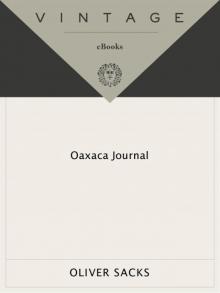 Oaxaca Journal
Oaxaca Journal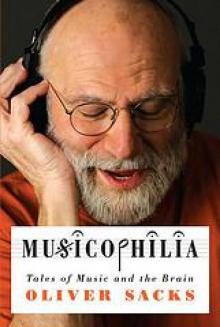 Musicophilia
Musicophilia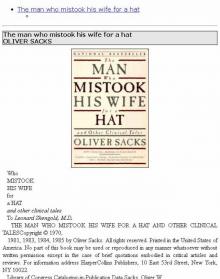 The man who mistook his wife for a hat
The man who mistook his wife for a hat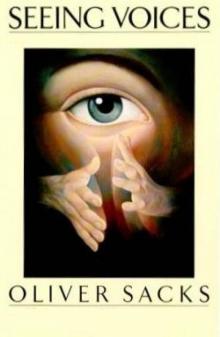 1989 - Seeing Voices
1989 - Seeing Voices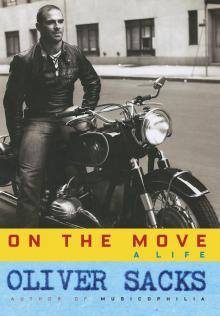 On the Move: A Life
On the Move: A Life 1996 - The Island of the Colorblind
1996 - The Island of the Colorblind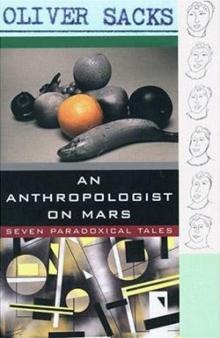 An Anthropologist on Mars: Seven Paradoxical Tales
An Anthropologist on Mars: Seven Paradoxical Tales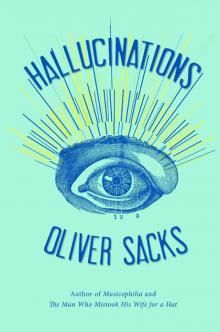 Hallucinations
Hallucinations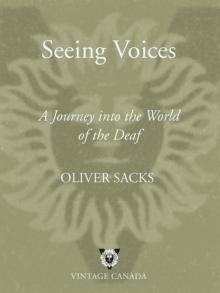 Seeing Voices
Seeing Voices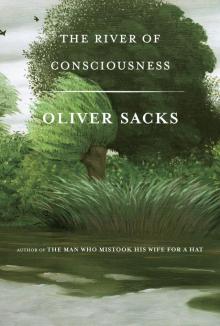 The River of Consciousness
The River of Consciousness Vintage Sacks
Vintage Sacks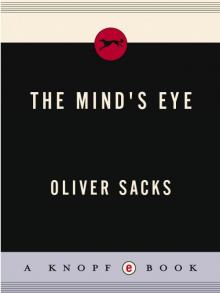 The Mind's Eye
The Mind's Eye Everything in Its Place
Everything in Its Place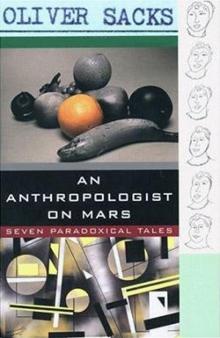 An Anthropologist on Mars (1995)
An Anthropologist on Mars (1995) Uncle Tungsten: Memories of a Chemical Boyhood (2001)
Uncle Tungsten: Memories of a Chemical Boyhood (2001)